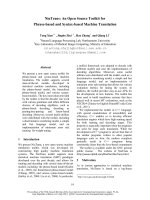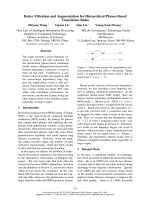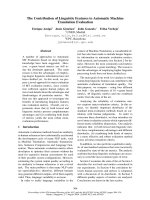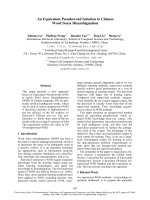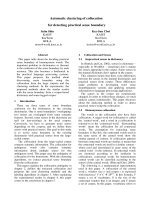Báo cáo khoa học: "An Open Source Toolkit for Tree/Forest-Based Statistical Machine Translation" ppt
Bạn đang xem bản rút gọn của tài liệu. Xem và tải ngay bản đầy đủ của tài liệu tại đây (559.57 KB, 6 trang )
Proceedings of the 50th Annual Meeting of the Association for Computational Linguistics, pages 127–132,
Jeju, Republic of Korea, 8-14 July 2012.
c
2012 Association for Computational Linguistics
Akamon: An Open Source Toolkit
for Tree/Forest-Based Statistical Machine Translation
∗
Xianchao Wu
†
, Takuya Matsuzaki
∗
, Jun’ichi Tsujii
‡
†
Baidu Inc.
∗
National Institute of Informatics
‡
Microsoft Research Asia
,,
Abstract
We describe Akamon, an open source toolkit
for tree and forest-based statistical machine
translation (Liu et al., 2006; Mi et al., 2008;
Mi and Huang, 2008). Akamon implements
all of the algorithms required for tree/forest-
to-string decoding using tree-to-string trans-
lation rules: multiple-thread forest-based de-
coding, n-gram language model integration,
beam- and cube-pruning, k-best hypotheses
extraction, and minimum error rate training.
In terms of tree-to-string translation rule ex-
traction, the toolkit implements the tradi-
tional maximum likelihood algorithm using
PCFG trees (Galley et al., 2004) and HPSG
trees/forests (Wu et al., 2010).
1 Introduction
Syntax-based statistical machine translation (SMT)
systems have achieved promising improvements in
recent years. Depending on the type of input, the
systems are divided into two categories: string-
based systems whose input is a string to be simul-
taneously parsed and translated by a synchronous
grammar (Wu, 1997; Chiang, 2005; Galley et al.,
2006; Shen et al., 2008), and tree/forest-based sys-
tems whose input is already a parse tree or a packed
forest to be directly converted into a target tree or
string (Ding and Palmer, 2005; Quirk et al., 2005;
Liu et al., 2006; Huang et al., 2006; Mi et al., 2008;
Mi and Huang, 2008; Zhang et al., 2009; Wu et al.,
2010; Wu et al., 2011a).
∗
Work done when all the authors were in The University of
Tokyo.
Depending on whether or not parsers are explic-
itly used for obtaining linguistically annotated data
during training, the systems are also divided into two
categories: formally syntax-based systems that do
not use additional parsers (Wu, 1997; Chiang, 2005;
Xiong et al., 2006), and linguistically syntax-based
systems that use PCFG parsers (Liu et al., 2006;
Huang et al., 2006; Galley et al., 2006; Mi et al.,
2008; Mi and Huang, 2008; Zhang et al., 2009),
HPSG parsers (Wu et al., 2010; Wu et al., 2011a), or
dependency parsers (Ding and Palmer, 2005; Quirk
et al., 2005; Shen et al., 2008). A classification
1
of
syntax-based SMT systems is shown in Table 1.
Translation rules can be extracted from aligned
string-string (Chiang, 2005), tree-tree (Ding and
Palmer, 2005) and tree/forest-string (Galley et al.,
2004; Mi and Huang, 2008; Wu et al., 2011a)
data structures. Leveraging structural and linguis-
tic information from parse trees/forests, the latter
two structures are believed to be better than their
string-string counterparts in handling non-local re-
ordering, and have achieved promising translation
results. Moreover, the tree/forest-string structure is
more widely used than the tree-tree structure, pre-
sumably because using two parsers on the source
and target languages is subject to more problems
than making use of a parser on one language, such
as the shortage of high precision/recall parsers for
languages other than English, compound parse error
rates, and inconsistency of errors. In Table 1, note
that tree-to-string rules are generic and applicable
to many syntax-based models such as tree/forest-to-
1
This classification is inspired by and extends the Table 1 in
(Mi and Huang, 2008).
127
Source-to-target Examples (partial) Decoding Rules Parser
tree-to-tree (Ding and Palmer, 2005) ↓ dep to-dep. DG
forest-to-tree (Liu et al., 2009a) ↓ ↑↓ tree-to-tree PCFG
tree-to-string (Liu et al., 2006) ↑ tree-to-string PCFG
(Quirk et al., 2005) ↑ dep to-string DG
forest-to-string (Mi et al., 2008) ↓ ↑↓ tree-to-string PCFG
(Wu et al., 2011a) ↓ ↑↓ tree-to-string HPSG
string-to-tree (Galley et al., 2006) CKY tree-to-string PCFG
(Shen et al., 2008) CKY string-to-dep. DG
string-to-string (Chiang, 2005) CKY string-to-string none
(Xiong et al., 2006) CKY string-to-string none
Table 1: A classification of syntax-based SMT systems. Tree/forest-based and string-based systems are split by a line.
All the systems listed here are linguistically syntax-based except the last two (Chiang, 2005) and (Xiong et al., 2006),
which are formally syntax-based. DG stands for dependency (abbreviated as dep.) grammar. ↓ and ↑denote top-down
and bottom-up traversals of a source tree/forest.
string models and string-to-tree model.
However, few tree/forest-to-string systems have
been made open source and this makes it diffi-
cult and time-consuming to testify and follow exist-
ing proposals involved in recently published papers.
The Akamon system
2
, written in Java and follow-
ing the tree/forest-to-string research direction, im-
plements all of the algorithms for both tree-to-string
translation rule extraction (Galley et al., 2004; Mi
and Huang, 2008; Wu et al., 2010; Wu et al., 2011a)
and tree/forest-based decoding (Liu et al., 2006; Mi
et al., 2008). We hope this system will help re-
lated researchers to catch up with the achievements
of tree/forest-based translations in the past several
years without re-implementing the systems or gen-
eral algorithms from scratch.
2 Akamon Toolkit Features
Limited by the successful parsing rate and coverage
of linguistic phrases, Akamon currently achieves
comparable translation accuracies compared with
the most frequently used SMT baseline system,
Moses (Koehn et al., 2007). Table 2 shows the auto-
matic translation accuracies (case-sensitive) of Aka-
mon and Moses. Besides BLEU and NIST score, we
further list RIBES score
3
, , i.e., the software imple-
mentation of Normalized Kendall’s τ as proposed by
(Isozaki et al., 2010a) to automatically evaluate the
translation between distant language pairs based on
rank correlation coefficients and significantly penal-
2
Code available at />3
Code available at />izes word order mistakes.
In this table, Akamon-Forest differs from
Akamon-Comb by using different configurations:
Akamon-Forest used only 2/3 of the total training
data (limited by the experiment environments and
time). Akamon-Comb represents the system com-
bination result by combining Akamon-Forest and
other phrase-based SMT systems, which made use
of pre-ordering methods of head finalization as de-
scribed in (Isozaki et al., 2010b) and used the total 3
million training data. The detail of the pre-ordering
approach and the combination method can be found
in (Sudoh et al., 2011) and (Duh et al., 2011).
Also, Moses (hierarchical) stands for the hi-
erarchical phrase-based SMT system and Moses
(phrase) stands for the flat phrase-based SMT sys-
tem. For intuitive comparison (note that the result
achieved by Google is only for reference and not a
comparison, since it uses a different and unknown
training data) and following (Goto et al., 2011), the
scores achieved by using the Google online transla-
tion system
4
are also listed in this table.
Here is a brief description of Akamon’s main fea-
tures:
• multiple-thread forest-based decoding: Aka-
mon first loads the development (with source
and reference sentences) or test (with source
sentences only) file into memory and then per-
form parameter tuning or decoding in a paral-
lel way. The forest-based decoding algorithm
is alike that described in (Mi et al., 2008),
4
/>128
Systems BLEU NIST RIBES
Google online 0.2546 6.830 0.6991
Moses (hierarchical) 0.3166 7.795 0.7200
Moses (phrase) 0.3190 7.881 0.7068
Moses (phrase)* 0.2773 6.905 0.6619
Akamon-Forest* 0.2799 7.258 0.6861
Akamon-Comb 0.3948 8.713 0.7813
Table 2: Translation accuracies of Akamon and the base-
line systems on the NTCIR-9 English-to-Japanese trans-
lation task (Wu et al., 2011b). * stands for only using
2 million parallel sentences of the total 3 million data.
Here, HPSG forests were used in Akamon.
i.e., first construct a translation forest by ap-
plying the tree-to-string translation rules to the
original parsing forest of the source sentence,
and then collect k-best hypotheses for the root
node(s) of the translation forest using Algo-
rithm 2 or Algorithm 3 as described in (Huang
and Chiang, 2005). Later, the k-best hypothe-
ses are used both for parameter tuning on addi-
tional development set(s) and for final optimal
translation result extracting.
• language models: Akamon can make use of
one or many n-gram language models trained
by using SRILM
5
(Stolcke, 2002) or the Berke-
ley language model toolkit, berkeleylm-1.0b3
6
(Pauls and Klein, 2011). The weights of multi-
ple language models are tuned under minimum
error rate training (MERT) (Och, 2003).
• pruning: traditional beam-pruning and cube-
pruning (Chiang, 2007) techniques are incor-
porated in Akamon to make decoding feasi-
ble for large-scale rule sets. Before decoding,
we also perform the marginal probability-based
inside-outside algorithm based pruning (Mi et
al., 2008) on the original parsing forest to con-
trol the decoding time.
• MERT: Akamon has its own MERT module
which optimizes weights of the features so as
to maximize some automatic evaluation metric,
such as BLEU (Papineni et al., 2002), on a de-
velopment set.
5
/>6
/>
e.tok
corpus
f.seg
tokenize
word segment
e.tok.lw
f.seg.lw
lowercase
lowercase
clean
e.
clean
f.
clean
GIZA++
alignment
Rule set
rule extraction
SRILM
Akamon Decoder (MERT)
N-gram LM
e.tok
dev.e
tokenize
e.tok.lw
lowercase
e.
forests
Enju
e.forests
Enju
dev
f
.
seg
dev.
f
word
segmentation
f
.
seg
.lw
lowercase
pre-processing
Figure 1: Training and tuning process of the Akamon sys-
tem. Here, e = source English language, f = target foreign
language.
• translation rule extraction: as former men-
tioned, we extract tree-to-string translation
rules for Akamon. In particular, we imple-
mented the GHKM algorithm as proposed by
Galley et al. (2004) from word-aligned tree-
string pairs. In addition, we also implemented
the algorithms proposed by Mi and Huang
(2008) and Wu et al. (2010) for extracting rules
from word-aligned PCFG/HPSG forest-string
pairs.
3 Training and Decoding Frameworks
Figure 1 shows the training and tuning progress of
the Akamon system. Given original bilingual par-
allel corpora, we first tokenize and lowercase the
source and target sentences (e.g., word segmentation
of Chinese and Japanese, punctuation segmentation
of English).
The pre-processed monolingual sentences will be
used by SRILM (Stolcke, 2002) or BerkeleyLM
(Pauls and Klein, 2011) to train a n-gram language
model. In addition, we filter out too long sentences
129
here, i.e., only relatively short sentence pairs will be
used to train word alignments. Then, we can use
GIZA++ (Och and Ney, 2003) and symmetric strate-
gies, such as grow-diag-final (Koehn et al., 2007),
on the tokenized parallel corpus to obtain a word-
aligned parallel corpus.
The source sentence and its packed forest, the tar-
get sentence, and the word alignment are used for
tree-to-string translation rule extraction. Since a 1-
best tree is a special case of a packed forest, we will
focus on using the term ‘forest’ in the continuing
discussion. Then, taking the target language model,
the rule set, and the preprocessed development set
as inputs, we perform MERT on the decoder to tune
the weights of the features.
The Akamon forest-to-string system includes the
decoding algorithm and the rule extraction algorithm
described in (Mi et al., 2008; Mi and Huang, 2008).
4 Using Deep Syntactic Structures
In Akamon, we support the usage of deep syn-
tactic structures for obtaining fine-grained transla-
tion rules as described in our former work (Wu et
al., 2010)
7
. Similarly, Enju
8
, a state-of-the-art and
freely available HPSG parser for English, can be
used to generate packed parse forests for source
sentences
9
. Deep syntactic structures are included
in the HPSG trees/forests, which includes a fine-
grained description of the syntactic property and a
semantic representation of the sentence. We extract
fine-grained rules from aligned HPSG forest-string
pairs and use them in the forest-to-string decoder.
The detailed algorithms can be found in (Wu et al.,
2010; Wu et al., 2011a). Note that, in Akamon, we
also provide the codes for generating HPSG forests
from Enju.
Head-driven phrase structure grammar (HPSG) is
a lexicalist grammar framework. In HPSG, linguis-
tic entities such as words and phrases are represented
by a data structure called a sign. A sign gives a
7
However, Akamon still support PCFG tree/forest based
translation. A special case is to yield PCFG style trees/forests
by ignoring the rich features included in the nodes of HPSG
trees/forests and only keep the POS tag and the phrasal cate-
gories.
8
/>9
Until the date this paper was submitted, Enju supports gen-
erating English and Chinese forests.
Feature Description
CAT phrasal category
XCAT fine-grained phrasal category
SCHEMA name of the schema applied in the node
HEAD pointer to the head daughter
SEM HEAD pointer to the semantic head daughter
CAT syntactic category
POS Penn Treebank-style part-of-speech tag
BASE base form
TENSE tense of a verb (past, present, untensed)
ASPECT aspect of a verb (none, perfect,
progressive, perfect-progressive)
VOICE voice of a verb (passive, active)
AUX auxiliary verb or not (minus, modal,
have, be, do, to, copular)
LEXENTRY lexical entry, with supertags embedded
PRED type of a predicate
ARG⟨x⟩ pointer to semantic arguments, x = 1 4
Table 3: Syntactic/semantic features extracted from
HPSG signs that are included in the output of Enju. Fea-
tures in phrasal nodes (top) and lexical nodes (bottom)
are listed separately.
factored representation of the syntactic features of
a word/phrase, as well as a representation of their
semantic content. Phrases and words represented by
signs are composed into larger phrases by applica-
tions of schemata. The semantic representation of
the new phrase is calculated at the same time. As
such, an HPSG parse tree/forest can be considered
as a tree/forest of signs (c.f. the HPSG forest in Fig-
ure 2 in (Wu et al., 2010)).
An HPSG parse tree/forest has two attractive
properties as a representation of a source sentence
in syntax-based SMT. First, we can carefully control
the condition of the application of a translation rule
by exploiting the fine-grained syntactic description
in the source parse tree/forest, as well as those in the
translation rules. Second, we can identify sub-trees
in a parse tree/forest that correspond to basic units
of the semantics, namely sub-trees covering a pred-
icate and its arguments, by using the semantic rep-
resentation given in the signs. Extraction of trans-
lation rules based on such semantically-connected
sub-trees is expected to give a compact and effective
set of translation rules.
A sign in the HPSG tree/forest is represented by a
typed feature structure (TFS) (Carpenter, 1992). A
TFS is a directed-acyclic graph (DAG) wherein the
edges are labeled with feature names and the nodes
130
She
ignore
fact
want
I
dispute
ARG1
ARG
2
ARG1
ARG1
ARG
2
ARG
2
John
kill
Mary
ARG2
ARG1
Figure 2: Predicate argument structures for the sentences
of “John killed Mary” and “She ignored the fact that I
wanted to dispute”.
(feature values) are typed. In the original HPSG for-
malism, the types are defined in a hierarchy and the
DAG can have arbitrary shape (e.g., it can be of any
depth). We however use a simplified form of TFS,
for simplicity of the algorithms. In the simplified
form, a TFS is converted to a (flat) set of pairs of
feature names and their values. Table 3 lists the fea-
tures used in our system, which are a subset of those
in the original output from Enju.
In the Enju English HPSG grammar (Miyao et
al., 2003) used in our system, the semantic content
of a sentence/phrase is represented by a predicate-
argument structure (PAS). Figure 2 shows the PAS
of a simple sentence, “John killed Mary”, and a more
complex PAS for another sentence, “She ignored the
fact that I wanted to dispute”, which is adopted from
(Miyao et al., 2003). In an HPSG tree/forest, each
leaf node generally introduces a predicate, which
is represented by the pair of LEXENTRY (lexical
entry) feature and PRED (predicate type) feature.
The arguments of a predicate are designated by the
pointers from the ARG⟨x⟩ features in a leaf node
to non-terminal nodes. Consequently, Akamon in-
cludes the algorithm for extracting compact com-
posed rules from these PASs which further lead to
a significant fast tree-to-string decoder. This is be-
cause it is not necessary to exhaustively generate the
subtrees for all the tree nodes for rule matching any
more. Limited by space, we suggest the readers to
refer to our former work (Wu et al., 2010; Wu et al.,
2011a) for the experimental results, including the
training and decoding time using standard English-
to-Japanese corpora, by using deep syntactic struc-
tures.
5 Content of the Demonstration
In the demonstration, we would like to provide a
brief tutorial on:
• describing the format of the packed forest for a
source sentence,
• the training script on translation rule extraction,
• the MERT script on feature weight tuning on a
development set, and,
• the decoding script on a test set.
Based on Akamon, there are a lot of interesting
directions left to be updated in a relatively fast way
in the near future, such as:
• integrate target dependency structures, espe-
cially target dependency language models, as
proposed by Mi and Liu (2010),
• better pruning strategies for the input packed
forest before decoding,
• derivation-based combination of using other
types of translation rules in one decoder, as pro-
posed by Liu et al. (2009b), and
• taking other evaluation metrics as the opti-
mal objective for MERT, such as NIST score,
RIBES score (Isozaki et al., 2010a).
Acknowledgments
We thank Yusuke Miyao and Naoaki Okazaki for
their invaluable help and the anonymous reviewers
for their comments and suggestions.
References
Bob Carpenter. 1992. The Logic of Typed Feature Struc-
tures. Cambridge University Press.
David Chiang. 2005. A hierarchical phrase-based model
for statistical machine translation. In Proceedings of
ACL, pages 263–270, Ann Arbor, MI.
David Chiang. 2007. Hierarchical phrase-based transla-
tion. Computational Lingustics, 33(2):201–228.
Yuan Ding and Martha Palmer. 2005. Machine trans-
lation using probabilistic synchronous dependency in-
sertion grammers. In Proceedings of ACL, pages 541–
548, Ann Arbor.
Kevin Duh, Katsuhito Sudoh, Xianchao Wu, Hajime
Tsukada, and Masaaki Nagata. 2011. Generalized
minimum bayes risk system combination. In Proceed-
ings of IJCNLP, pages 1356–1360, November.
Michel Galley, Mark Hopkins, Kevin Knight, and Daniel
Marcu. 2004. What’s in a translation rule? In Pro-
ceedings of HLT-NAACL.
131
Michel Galley, Jonathan Graehl, Kevin Knight, Daniel
Marcu, Steve DeNeefe, Wei Wang, and Ignacio
Thayer. 2006. Scalable inference and training of
context-rich syntactic translation models. In Proceed-
ings of COLING-ACL, pages 961–968, Sydney.
Isao Goto, Bin Lu, Ka Po Chow, Eiichiro Sumita, and
Benjamin K. Tsou. 2011. Overview of the patent ma-
chine translation task at the ntcir-9 workshop. In Pro-
ceedings of NTCIR-9, pages 559–578.
Liang Huang and David Chiang. 2005. Better k-best
parsing. In Proceedings of IWPT.
Liang Huang, Kevin Knight, and Aravind Joshi. 2006.
Statistical syntax-directed translation with extended
domain of locality. In Proceedings of 7th AMTA.
Hideki Isozaki, Tsutomu Hirao, Kevin Duh, Katsuhito
Sudoh, and Hajime Tsukada. 2010a. Automatic eval-
uation of translation quality for distant language pairs.
In Proc.of EMNLP, pages 944–952.
Hideki Isozaki, Katsuhito Sudoh, Hajime Tsukada, and
Kevin Duh. 2010b. Head finalization: A simple re-
ordering rule for sov languages. In Proceedings of
WMT-MetricsMATR, pages 244–251, July.
Philipp Koehn, Hieu Hoang, Alexandra Birch, Chris
Callison-Burch, Marcello Federico, Nicola Bertoldi,
Brooke Cowan, Wade Shen, Christine Moran, Richard
Zens, Chris Dyer, Ond
ˇ
rej Bojar, Alexandra Con-
stantin, and Evan Herbst. 2007. Moses: Open source
toolkit for statistical machine translation. In Proceed-
ings of the ACL 2007 Demo and Poster Sessions, pages
177–180.
Yang Liu, Qun Liu, and Shouxun Lin. 2006. Tree-
to-string alignment templates for statistical machine
transaltion. In Proceedings of COLING-ACL, pages
609–616, Sydney, Australia.
Yang Liu, Yajuan L
¨
u, and Qun Liu. 2009a. Improving
tree-to-tree translation with packed forests. In Pro-
ceedings of ACL-IJCNLP, pages 558–566, August.
Yang Liu, Haitao Mi, Yang Feng, and Qun Liu. 2009b.
Joint decoding with multiple translation models. In
Proceedings of ACL-IJCNLP, pages 576–584, August.
Haitao Mi and Liang Huang. 2008. Forest-based transla-
tion rule extraction. In Proceedings of EMNLP, pages
206–214, October.
Haitao Mi and Qun Liu. 2010. Constituency to depen-
dency translation with forests. In Proceedings of ACL,
pages 1433–1442, July.
Haitao Mi, Liang Huang, and Qun Liu. 2008. Forest-
based translation. In Proceedings of ACL-08:HLT,
pages 192–199, Columbus, Ohio.
Yusuke Miyao, Takashi Ninomiya, and Jun’ichi Tsujii.
2003. Probabilistic modeling of argument structures
including non-local dependencies. In Proceedings of
RANLP, pages 285–291, Borovets.
Franz Josef Och and Hermann Ney. 2003. A system-
atic comparison of various statistical alignment mod-
els. Computational Linguistics, 29(1):19–51.
Franz Josef Och. 2003. Minimum error rate training in
statistical machine translation. In Proceedings of ACL,
pages 160–167.
Kishore Papineni, Salim Roukos, Todd Ward, and Wei-
Jing Zhu. 2002. Bleu: a method for automatic evalu-
ation of machine translation. In Proceedings of ACL,
pages 311–318.
Adam Pauls and Dan Klein. 2011. Faster and smaller n-
gram language models. In Proceedings of ACL-HLT,
pages 258–267, June.
Chris Quirk, Arul Menezes, and Colin Cherry. 2005. De-
pendency treelet translation: Syntactically informed
phrasal smt. In Proceedings of ACL, pages 271–279.
Libin Shen, Jinxi Xu, and Ralph Weischedel. 2008. A
new string-to-dependency machine translation algo-
rithm with a target dependency language model. In
Proceedings of ACL-08:HLT, pages 577–585.
Andreas Stolcke. 2002. Srilm-an extensible language
modeling toolkit. In Proceedings of International
Conference on Spoken Language Processing, pages
901–904.
Katsuhito Sudoh, Kevin Duh, Hajime Tsukada, Masaaki
Nagata, Xianchao Wu, Takuya Matsuzaki, and
Jun’ichi Tsujii. 2011. Ntt-ut statistical machine trans-
lation in ntcir-9 patentmt. In Proceedings of NTCIR-9
Workshop Meeting, pages 585–592, December.
Xianchao Wu, Takuya Matsuzaki, and Jun’ichi Tsujii.
2010. Fine-grained tree-to-string translation rule ex-
traction. In Proceedings of ACL, pages 325–334, July.
Xianchao Wu, Takuya Matsuzaki, and Jun’ichi Tsujii.
2011a. Effective use of function words for rule gen-
eralization in forest-based translation. In Proceedings
of ACL-HLT, pages 22–31, June.
Xianchao Wu, Takuya Matsuzaki, and Jun’ichi Tsujii.
2011b. Smt systems in the university of tokyo for
ntcir-9 patentmt. In Proceedings of NTCIR-9 Work-
shop Meeting, pages 666–672, December.
Dekai Wu. 1997. Stochastic inversion transduction
grammars and bilingual parsing of parallel corpora.
Computational Linguistics, 23(3):377–403.
Deyi Xiong, Qun Liu, and Shouxun Lin. 2006. Maxi-
mum entropy based phrase reordering model for statis-
tical machine translation. In Proceedings of COLING-
ACL, pages 521–528, July.
Hui Zhang, Min Zhang, Haizhou Li, Aiti Aw, and
Chew Lim Tan. 2009. Forest-based tree sequence
to string translation model. In Proceedings of ACL-
IJCNLP, pages 172–180, Suntec, Singapore, August.
132

